
Kannur is one of the 14 districts along the west coast in the state of Kerala, India. The city of Kannur is the district headquarters and gives the district its name. The old name, Cannanore, is the anglicized form of the Malayalam name "Kannur". Kannur district is bounded by Kasaragod District to the north, Kozhikode district to the south, Mahé district to the southwest and Wayanad District to the southeast. To the east, the district is bounded by the Western Ghats, which forms the border with the state of Karnataka. The Arabian Sea lies to the west. Paithalmala is the highest point in Kannur District (1,372m). Enclosed within the southern part of the district is the Mahé district of the Union Territory of Puducherry. The district was established in 1957.
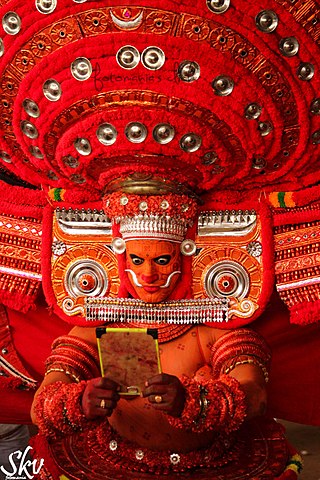
Theyyam is a Hindu religious ritual practiced in northern Kerala and some parts of Karnataka. Theyyam is also known as Kaḷiyāṭṭaṁ or Tiṟa. Theyyam consists of traditions, rituals and customs associated with temples and sacred groves of Malabar. The people of the region consider Theyyam itself as a channel to a god and they thus seek blessings from Theyyam.

Parassinikadavu Muthappan temple is a temple located at Parassinikadavu in Anthoor municipality on the banks of the Valapattanam river about 10 km (6.2 mi) from Taliparamba and 20 km (12 mi) from Kannur town in Kannur district, Kerala, India. Thiyya community urayima Principal deity of the temple is Sree Muthappan, whose divinity is presented as a ritualistic theyyam enactment in two versions called Thiruvappan and Vellattam. According to the local tradition the presiding deity is a manifestation of Lord Shiva.
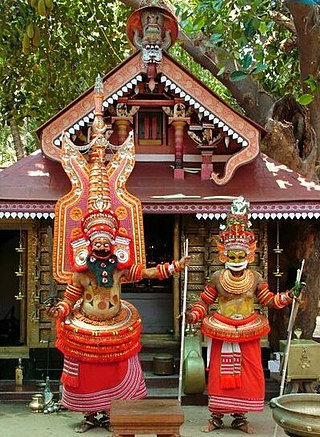
Muthappan is a deity commonly worshiped in the Kannur, Kasargod, Kozhikode, Malappuram region of Kerala and Coorg region of Karnataka in India. Muthappan is considered as the personification of two Hindu gods — the Thiruvappan or Valiya Muthapan (Vishnu) and the Vellatom or Cheriya Muthapan (Shiva).
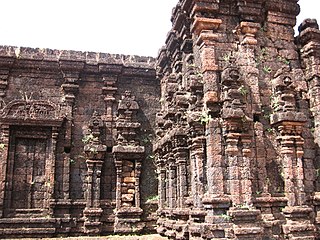
The Rajarajeshwara temple is a Shiva temple located in Taliparamba in Kannur district of Kerala State of India. The temple is regarded as one of the existing 108 ancient Shiva Temples of ancient Kerala. It also has a prominent place amongst the numerous Shiva temples in South India. It had the tallest shikhara amongst the temples of its time. The Rajarajeshwara temple has a top of about 90 tonnes. If any problem is encountered in the other temples of South India, devotees seek a solution in this temple through a prashnam, a traditional method of astrological decision-making. The prashnam is conducted on a peedha outside the temple.

Bhadrakali is a Hindu goddess. She is considered to be the auspicious and fortunate form of Adi Shakti who protects the good, known as bhadra.
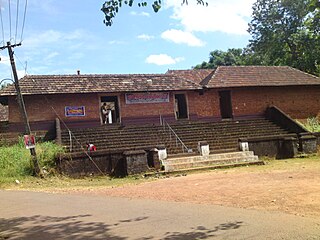
Sree Oorpazhachi Kavu is a Hindu temple in the Edakkad grama panchayat in Kannur District of Kerala state in southern India.

Thiruvarkadu Bhagavathi Temple is the mother temple of all Bhadrakali shrines of Kerala. The deity is the Fierce form of Bhadrakali. The Bhagavathy is addressed by tantrics in the vicinity as Tiruvarkkad Achchi due to this. The temple administration is Malabar Devaswom Board. The temple is a revered shrine of Chirakkal Royal Family and a shrine of Chirakkal devaswom before. The temple is situated in Madayi, Payangadi, hence prominently known as Madayi Kavu.
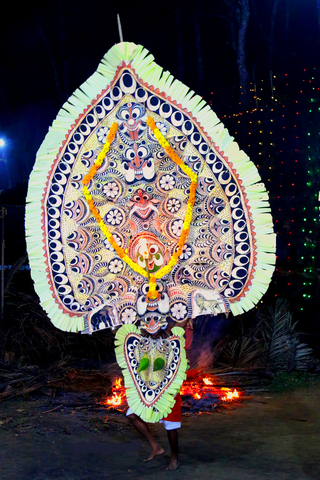
Padayani, also known Padeni, is a traditional folk dance and a ritual art from the central portion of the Indian state of Kerala. A ceremonial dance involving masks, it is an ancient ritual performed in Bhagavati temples. The dance is performed in honor of Bhadrakaali. Meaning, a 'row of warriors', Padayani is an art form that blends all music, dance, theatre, satire, facial masks, and paintings. It is part of worship of Bhadrakali and is staged in temples dedicated to the goddess from mid-December to mid-May. Padayani is unique to central Travancore, comprising the Pathanamthitta and Kottayam districts of Kerala. It is also performed in adjoining regions of Kollam, Alappuzha districts.

Pottan Theyyam is a vivid, lively and colorful ritualistic dance which comes in the traditional art form of theyyam, and is an essential part of the cultural heritage of Kolathunadu, a territory comprising present day Kannur district and parts of Kozhikode and Kasaragod districts of northern Kerala, India.

Kalarivathukkal Bhagavathy Temple, Bhadrakali Shrine located near Valapattanam river, is the family shrine of Chirakkal Royal Family. The deity of the shrine is the fierce form of Bhadrakali. Kalarivathukkal Bhagavathy is considered as the mother of the ancient martial art Kalarippayattu and hence the name. The shrine is administered by Malabar Devaswom Board and classified as Category A Temple of the board. Kalarivathukkal has come from the word Kalari Vaatilkal.
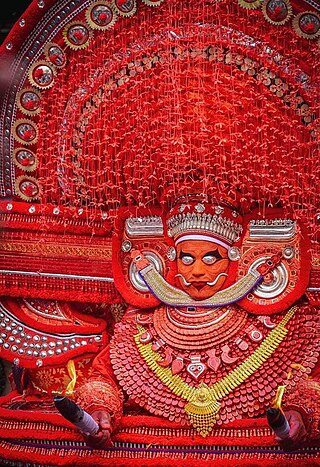
Muchilot Bhagavathi is the tutelary deity of the Vaniyas social class of North Malabar, in southwest India. Muchilot Bhagavathi is also worshipped as Eezhala Bhagavati, Kaniyal bagavathi and Maññaḷamma. There are more than 108 Muchilot temples spread across Northern Kerala.
This is a list of ancient Buddhist sites, relics, traditions and places from the Indian state of Kerala. Even though Kerala does not have any major presence of Buddhists in modern times, many historians recognize a Buddhist heritage that seem to have existed until the 10th century CE along with a widespread Sramana tradition of co-existence between Buddhism, Jainism and ancient Dravidian folk religion.

Mappila Theyyams are a variant of Theyyam performed in North Malabar especially in Kasaragod district it is related to the Mappila Muslims of Malabar Coast. This Theyyam is deified by Mavilan, Koppalan and Vannan communities and is done with the cooperation of Hindus and Muslims. The characters of this theyyam are mostly spirits of Mappilas that are related to the local deities. The common names of male Mappila theyyams are Aali, Aandi, Mukri, Poker, Bappiriyan, Kunhali, Mammu, Mammad etc. Ummachi and Naithiyar are the common names attributed to female theyyams.The dialogues of Mappila theyyams have mentions about Islamic migration to Kerala in the 7th century and communal harmony.

Kathivanoor Veeran is a deity worshiped in North Malabar region in Kerala, India. The word 'Veeran' in Malayalam means 'Hero' in English. According to the myths, the Kathivanoor Veeran is apotheosis of Thiyya warrior Mandappan Chekavar. Mandappan's life and his transformation into god are still active in the folklore of Kolathunadu region, and is practiced as theyyam in various temples in present-day Kannur and Kasaragod districts. Kathivanoor Veeran Theyyam is one of the most popular Theyyams in North Malabar. Women of North Malabar region worship Kathivanoor Veeran to get a healthy husband.

Vasoorimala is a female deity worshiped in many parts of Kerala and Kodagu region of Karnataka. She is worshipped as an Upa Devata (sub-deity) in Bhadrakali or Shiva temples. Vasoorimala is believed to be a deity that prevents contagious diseases like smallpox, chickenpox, and measles. In North Kerala, Vasoorimala is worshipped and performed as Vasoorimala Theyyam. According to myths, Manodari, wife of Asura named Darikan was later named as Vasoorimala.

Poomala Bhagavathy also known as Aryapoomala or Aryappunkani is a female deity worshipped in North Malabar region in Kerala, India. Poomala is worshiped mainly by the Thiyya community. The main temples of this deity is spread over Kannur and Kasaragod districts.
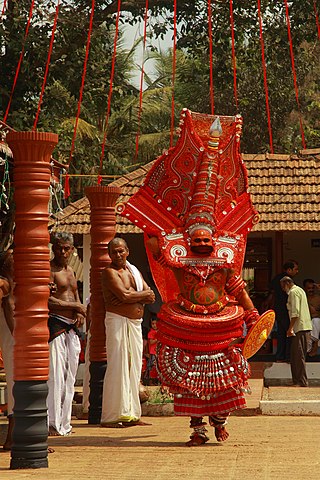
Poomaruthan Theyyam is a Hindu god popular in the North Malabar region of Kerala, India. This theyyam is performed in the shrines of the regional Hindu goddess Poomala bhagavathy. Poomala and Poomaruthan are worshiped mainly by the Thiyya community. The main temples where this theyyam is performed are spread over Kannur and Kasaragod districts.
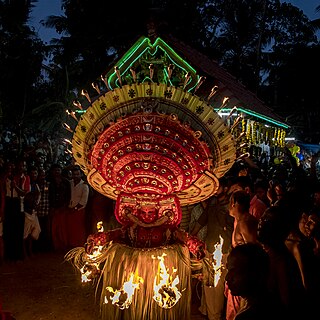
Kadangot Makkam, is a regional Hindu goddess worshiped in the North Malabar region in Kerala, India. Makkam is worshipped and performed as Theyyam form, known as Makkappothi or Makkavum makkalum.



















